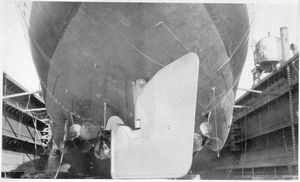Catalogue number 35269
Propellers, HMS Ramillies, laid down 1913, completed 1917
The last element in the propulsion system of a warship is the propeller. This photograph shows HMS Ramillies (laid down 1913, completed 1917) in dry-dock with the keel and three of the four 3-blade screws showing. The outer screws were 9ft 3 in diameter, the inner screws 10ft, the propeller pitch (distance the propeller would theoretically move forward in one revolution) was outer screws 9ft 6in, inner screws 10ft. They turned at 300 rpm powered by Parsons turbines and Babock and Wilcox boilers for a design speed of 23 kts (full trials were never made, this class of ships going straight into war service, average speed for Ramillies is given as 20.5kts). The high pressure ahead and astern plus cruising turbines acted on the outer shafts, the low pressure ahead and astern turbines acted on the inner shafts.
Verso: "screws & rudder. Ramillies"
13.4cm x 8cm Gelatin silver print
|
 |